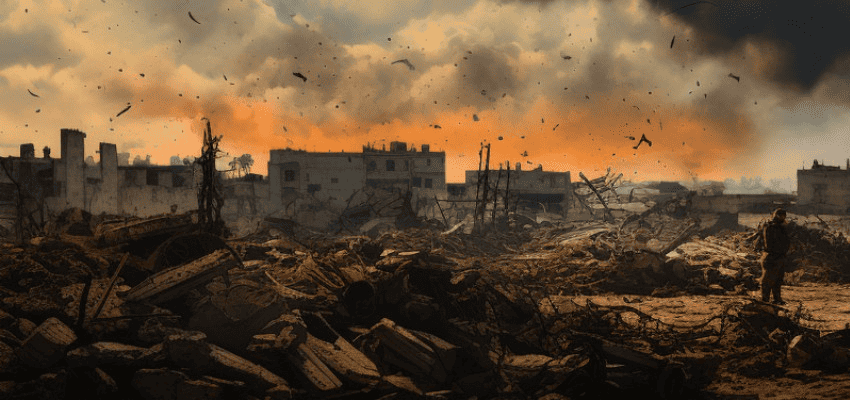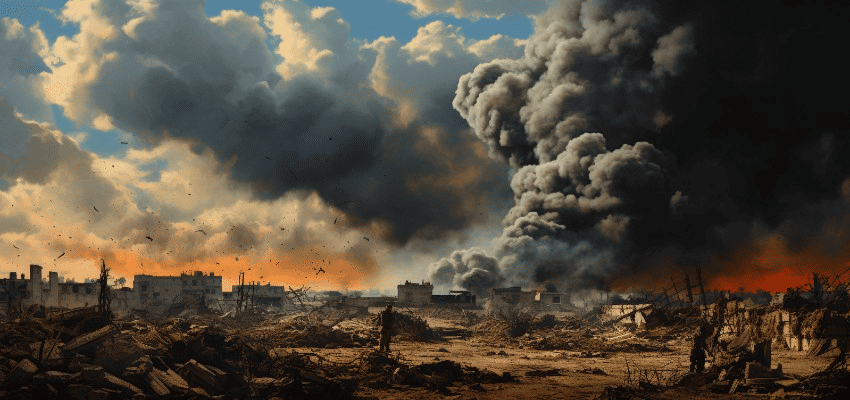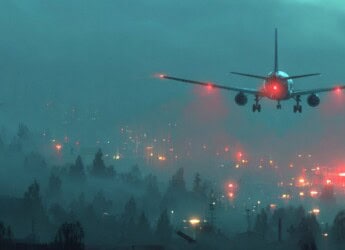|
|
ARCHIVED CONTENT
You are viewing ARCHIVED CONTENT released online between 1 April 2010 and 24 August 2018 or content that has been selectively archived and is no longer active. Content in this archive is NOT UPDATED, and links may not function.Content Assessment: Iran Mobilizes Proxies as Conflict Between Israel and Palestinian Militants Threatens to Expand (October 10-16, 2023)
Information
Insight
Relevance
Objectivity
Authority
Excellent
A short assessment of the qualitative benefit of the recent update on Iran and Iranian-sponsored activities manifesting in an Israel-Hamas War prepared by ComplexDiscovery from reporting and maps sourced from Institute of the Study of War.
Editor’s Note: The Institute for the Study of War provides invaluable insights into Iranian activities and dynamics through its regular Iran Update briefings. Published in coordination with the Critical Threats Project at the American Enterprise Institute, these updates offer in-depth analysis of Iranian-sponsored activities across the Middle East and beyond. Recently CTP and ISW have refocused updates to cover the Israel-Hamas war. The new sections address developments in the Gaza Strip, the West Bank, Lebanon, and Syria, as well as noteworthy activity from Iran’s Axis of Resistance.
For ongoing coverage of Iranian activities across the Middle East and the current Israel-Hamas War, the Institute for the Study of War also provides maps charting influence, activities, and outbreaks across the region. These maps present vital information about Iranian proxies and allies. They also show how Tehran projects power to pursue its strategic goals. The Iran Updates and supporting maps offer vital resources to track Iran’s destabilizing actions and manifestations, such as the Israel-Hamas War.
Today’s Iranian Update coverage by ComplexDiscovery OÜ spans October 10-16, 2023, with coverage spurred by the unprecedented attack by the Palestinian militant group Hamas on Israel on October 7, 2023. This dangerous regional escalation with international implications will continue to be covered by ComplexDiscovery OÜ in addition to its regular reporting on the Russo-Ukrainian War.
Source Note: One of the most accurate and detailed sources for ongoing updates on the Middle East crisis is the Iran Update from the Institute for the Study of War. The Institute for the Study of War (ISW) is a 501(c)(3) organization and produces strictly non-partisan, non-ideological, fact-based research. ISW seeks to promote an informed understanding of war and military affairs through comprehensive, independent, and accessible open-source research and analysis. ISW’s research is made available to the general public, military practitioners, policymakers, and media members. Providing a regular synthesis of key events related to Iranian activities in the region, ISW updates may benefit investigators and litigators as they follow the business, information technology, and legal trends and trajectories impacted by and stemming from Iran’s destabilizing actions across the Middle East and the current hostilities in the Isreal-Hamas War.
For those seeking to grasp the full scope of this evolving landscape, the complete updates from the Institute for the Study of War serve as an invaluable resource.
Assessments and Maps*
Middle Eastern Conflict Assessments
- Institute for the Study of War (ISW)
- Critical Threats Project (CTP), American Enterprise Institute
General Assessment Background Info
- ISW systematically publishes Iran Updates, including maps highlighting key events and activities.
- Maps augment regular synthetic products that cover key events related to potential Iran-sponsored activities across the Middle East.
Iran Update Summary (October 10-16, 2023)
Clashes Between Israel and Palestinian Militants Continue in Gaza and West Bank
Hamas incursions into southern Israel by land and sea have slowed since October 9, according to a new report by the Institute for the Study of War (ISW). Palestinian militant groups are now relying more on rocket barrages and attack drones to hit towns in northern and southern Israel. Rocket fire from Gaza extended as far north as Haifa, and multiple barrages have struck Tel Aviv, the report stated.
The Hamas spokesperson had warned Israeli civilians to evacuate Ashkelon near the Gaza border on October 10 before launching hundreds of rockets, claiming the attack was in retaliation for Israeli airstrikes on Gaza. Such warnings have not preceded Hamas rocket attacks previously. Israel conducted strikes on over 1,270 locations in Gaza and killed at least three Hamas leaders during October 9 and 10, the report noted.
The ISW report highlighted that the Israel Defense Forces (IDF) spokesperson stated early on October 10 that its forces had regained control of the Gaza border. However, clashes continued in isolated pockets immediately north and east of the Gaza Strip on October 10 and 11.
In the West Bank, the Lions’ Den militia mobilized supporters to hold marches and engage in small arms clashes with Israeli security forces, according to the ISW update. Small arms clashes and marches took place in approximately 19 locations across the West Bank after the Lions’ Den called for its supporters to take to the street.
The report pointed out that Hamas also released a separate statement calling on supporters in the West Bank to storm Jerusalem on October 13. The ISW update suggested these separate calls may indicate Palestinian militias are struggling to coordinate mobilization efforts between Gaza and the West Bank.
Rockets Fired from Lebanon as Conflict Between Israel and Palestinian Groups Continues
Incursions by Hamas into southern Israel have slowed further since October 9, according to the Institute for the Study of War. Palestinian militias in Gaza are now primarily using drones and rockets to strike towns in northern and southern Israel.
The West Bank-based militia Lions’ Den again mobilized supporters on October 11 to hold marches and engage in small arms clashes with Israeli security forces across the West Bank. This came in response to the group’s calls for Palestinians to demonstrate and conduct attacks.
Notably, Lebanese Hezbollah fired missiles, including anti-tank munitions, at Israeli security forces in northern Israel on October 11. Hezbollah claimed responsibility for the attack, stating it was in response to Israel’s killing of Hezbollah fighters in an airstrike on October 9.
Hezbollah also launched an attempted infiltration to capture an Israeli town on the northern border on October 11, according to the ISW update. Additionally, unspecified militants launched rocket barrages into open areas of northern Israel over October 9 and 10.
The ISW report highlighted that the rockets fired from Lebanon into Israel mark the first attacks from outside of Gaza and the West Bank during this conflict. The update stated this is consistent with the threat of the war expanding into a multi-front confrontation.
Iran Threatens US Forces as Conflict Between Israel and Palestinian Groups Continues
Hamas continued rocket attacks from Gaza into southern Israel on October 12 but reduced the rate of these attacks, according to the Institute for the Study of War. Small arms clashes between Palestinian militants and Israeli forces also increased slightly across the West Bank.
Notably, the ISW update reported that unidentified Iranian officials implicitly threatened to direct proxy attacks against US forces in Iraq and Syria if the United States re-freezes Iranian financial assets abroad.
The officials told media that the prisoner swap deal between the US and Iran in August 2023 involved a broader understanding that Iran would pause proxy attacks on US positions in exchange for the US allowing release of frozen Iranian assets. The US and Qatar have now reportedly agreed to re-freeze these assets.
The ISW report suggested the threats highlight the risk of the conflict between Israel and Palestinian groups expanding throughout the region and drawing in more actors.
The update also noted that Iranian Foreign Minister Hossein Amirabdollahian conducted diplomatic visits to Iraq, Lebanon and Syria, likely to coordinate with leaders of Iran’s “Axis of Resistance.”
Iran Calls to Expand Conflict as Israel Strikes Syria
Hamas continued rocket attacks into Israel at a lower rate on October 13 after reducing its rate of fire the previous day, according to the Institute for the Study of War. Small arms clashes between Palestinian militants and Israeli forces increased across the West Bank.
The ISW update stated that the Iranian regime is calling for expanding the conflict beyond Israel and the Palestinian territories, while trying to intensify violence against Israel in the West Bank.
Additionally, the report noted that Lebanese Hezbollah fired missiles, including anti-tank munitions, at Israeli security forces in northern Israel on October 13.
Importantly, the ISW analysis highlighted that Israel conducted airstrikes on the Damascus and Aleppo international airports in Syria on October 12. The strikes targeted critical nodes through which Iran transfers military equipment and personnel.
The daily report suggested the Israeli airstrikes in Syria, alongside Iranian calls to widen the war and ongoing clashes, underscore the risk of the conflict spreading throughout the region.
Iran and Proxies Threaten Intervention as Israel-Palestinian Clashes Continue
Hamas continued its ground and rocket attacks into Israel, primarily southern Israel, on October 14 according to the Institute for the Study of War. Palestinian militants also continued limited attempts to infiltrate southern Israel via land and sea.
The rate of clashes between Israeli forces and Palestinian militants in the West Bank decreased after peaking on October 13, though Hamas remains committed to expanding the conflict there, the ISW update stated.
Additionally, Lebanese Hezbollah claimed further attacks on the Israeli Defense Forces, part of its ongoing harassment campaign against Israeli forces in the north.
The daily report highlighted that Iranian officials and Iran’s “Axis of Resistance” proxies are threatening to intervene if Israel continues its military operations in Gaza. The IRGC has deployed engineers and missile experts to southwestern Syria as well.
The ISW analysis suggested these threats and deployments demonstrate the risk of the conflict expanding into a multi-front war surrounding Israel.
Lebanon Hezbollah Escalates as Iran Calls for Multi-Front War
Palestinian militias continued drone and rocket attacks into Israel, primarily southern Israel, on October 15 according to the Institute for the Study of War. There were no reported infiltrations into southern Israel.
Also highlighted was Lebanese Hezbollah expanded its attacks against the Israeli Defense Forces along the Israel-Lebanon border in terms of location, pace and actors involved.
The daily ISW report highlighted that Iranian Foreign Minister Hossein Amirabdollahian warned a multi-front war against Israel is becoming more likely, and Iranian-backed militias may take preemptive actions against Israel soon.
Additionally, the update noted the IRGC is trying to improve operational security in eastern Syria likely to move advanced systems into Syria and Lebanon.
Iran Sends Reinforcements as Conflict Between Israel and Militants Continues
Palestinian militias continued drone and indirect fire attacks into Israel, primarily southern Israel, on October 16 according to the Institute for the Study of War. The rate of clashes in the West Bank dropped slightly after peaking on October 13.
Lebanese Hezbollah claimed additional attacks on the Israeli Defense Forces in northern Israel, expanding westward along the Israel-Lebanon border.
Importantly, the ISW update reported that Iranian Foreign Minister Hossein Amirabdollahian again warned a multi-front war against Israel is becoming likely. He stated Iranian-backed militias may take preemptive actions against Israel in the coming hours.
The report also noted the Islamic Revolutionary Guard Corps is improving operational security in eastern Syria, likely to move advanced military systems into Syria and Lebanon.
Additionally, the analysis highlighted that 250-500 Iraqi Popular Mobilization Forces, an Iranian-backed militia, arrived in Syria and Lebanon on October 16.
In summary, the Institute for the Study of War reports detail ongoing clashes between Israel and Palestinian militant groups in Gaza and the West Bank from October 10-16. The updates also highlight concerning escalation by Lebanese Hezbollah in northern Israel and threats from Iran about opening new fronts in the conflict. The ISW analyses underscore the risk of the war expanding across multiple borders as Iran mobilizes proxies in the region.
For complete reporting, visit the Institute for the Study of War.
We do not report in detail on war crimes because those activities do not directly affect the military operations being assessed and forecast. We will continue to evaluate and report on the effects of reported criminal activities. We utterly condemn violations of the laws of armed conflict and the Geneva Conventions.
Detailed Reports with Selected Maps from the ISW – Mouseover to Scroll
October 16, 2023 Iran Update* Shared with express permission from the Institute for the Study of War (ISW).
About the Institute for the Study of War Research Methodology
ISW’s research methodology relies on both primary and secondary sources, enabling researchers to develop a comprehensive understanding of the situation on the ground. In order to analyze military and political developments in any given area, ISW’s research analysts must wholly understand the systems of enemy and friendly forces. They must also understand the population demographics, physical terrain, politics, and history of that area. This lays the analytical foundation for understanding the reasons for particular developments and fulfilling their assigned research objectives. ISW analysts also spend time in places like Iraq, Afghanistan, and elsewhere in order to gain a better understanding of the security and political situation and to evaluate the implementation of current strategies and policies. Our researchers compile data and analyze trends, producing a granular analysis of developments in areas of research, producing an accurate, high-resolution, timely, and thorough picture of the situation. ISW’s research methodology guarantees its success and commitment to improving the nation’s ability to execute military operations, achieve strategic objectives, and respond to emerging problems that may require the use of American military power.
About the Institute for the Study of War
The Institute for the Study of War advances an informed understanding of military affairs through reliable research, trusted analysis, and innovative education. We are committed to improving the nation’s ability to execute military operations and respond to emerging threats in order to achieve U.S. strategic objectives. ISW is a non-partisan, non-profit, public policy research organization.
Learn more, get involved, and contribute today.
Additional Reading
- From Dissent to OSINT? Understanding, Influencing, and Protecting Roles, Reputation, and Revenue
- [Annual Update] International Cyber Law in Practice: Interactive Toolkit
- Data Embassies: Sovereignty, Security, and Continuity for Nation-States
Assisted by GAI and LLM Technologies
Source: ComplexDiscovery







































